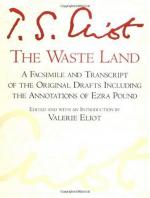|
This section contains 507 words (approx. 2 pages at 400 words per page) |

|
World War I
While Eliot published The Waste Land in 1922, it was widely acknowledged as reflecting the disillusionment in Europe following World War I. This global war started from a regional tragedy. On June 28, 1914, Archduke Franz Ferdinand, heir to the Austro-Hungarian throne, made a fateful trip to Sarajevo, capital city of Bosnia and Herzegovinatwo provinces under his family's controlwhere he and his wife were assassinated. These murders reflected a regional tension among some residents of the two provinces, which wished to become part of Serbia once again. Serbia, which also wished to reclaim Bosnia and Herzegovina, helped stage the assassinations. When this fact was realized by Austria-Hungary, the leaders of this nation state declared war on Serbia on July 28, exactly one month after the assassination. In times past this might have been a localized battle between two countries. But due to an extensive system of pre-existing...
|
This section contains 507 words (approx. 2 pages at 400 words per page) |

|




